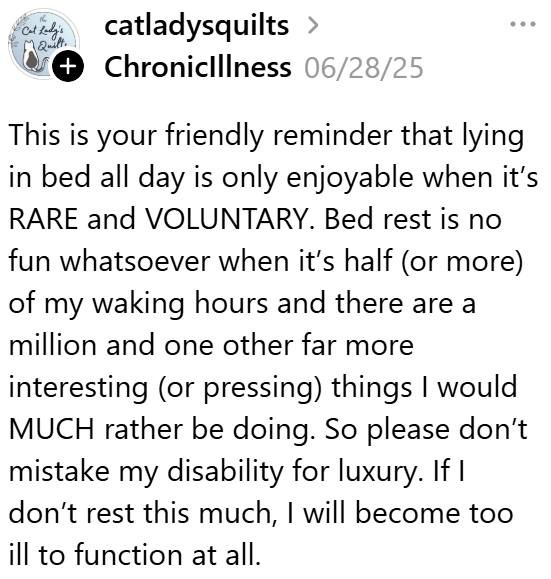#MutualAidRequest I am almost out of my meds for chronic pain + PTSD & other things since it's gotten cold and the chill is getting to me every minute of every day now, even inside with the heat on.
Goal: $0/30
Venmo: ErikaAutumn
other platforms: message please
It's also my birthday in a week if anyone wants to send more as a treat I'd be incredibly thankful 🤷♀️ I am well below the poverty line.
#MutualAid #PTSD #ChronicPain #LGBT #LGBTQ #trans #PleaseBoost
I am running into a "mental block" I could use some help with.
I feel "guilty" when I use stuff like Biofreeze or Tiger Balm in fair amount to control my pain, even though it works well and can dramatically improve my mood and function.
This seems silly. but I still find myself resistant. Like I am cheating. Quite opposite of what I would tell anyone in my position.
Do you have experience with this?
#MutualAidRequest I am almost out of my meds for chronic pain + PTSD & other things since it's gotten cold and the chill is getting to me every minute of every day now, even inside with the heat on.
Goal: $0/30
Venmo: ErikaAutumn
other platforms: message please
It's also my birthday in a week if anyone wants to send more as a treat I'd be incredibly thankful 🤷♀️ I am well below the poverty line.
#MutualAid #PTSD #ChronicPain #LGBT #LGBTQ #trans #PleaseBoost
Morning Twters.
#Fatigue has hit HARD today, so other than a shopping delivery, I'm resting because I don't have a choice in that. Feel like I've been hit by a truck of pain and fatigue.
Luckily a quiet physical day tomorrow as well. I can see lots of bed rest.
Hope you're all smashing the week so far! 😘
Are you a software professional living with chronic pain?
We’re studying how chronic pain affects software professionals. By sharing your experience, you’ll help us understand developers’ challenges and improve work sustainability.
☕ We’d love to hear your story over a digital coffee!
👉 Sign up: https://fmru.az1.qualtrics.com/jfe/form/SV_85NGp3dCl9i8R2S
Interviews are conducted in English or Portuguese by a researcher (me!) who also lives with chronic pain.
Are you a software professional living with chronic pain?
We’re studying how chronic pain affects software professionals. By sharing your experience, you’ll help us understand developers’ challenges and improve work sustainability.
☕ We’d love to hear your story over a digital coffee!
👉 Sign up: https://fmru.az1.qualtrics.com/jfe/form/SV_85NGp3dCl9i8R2S
Interviews are conducted in English or Portuguese by a researcher (me!) who also lives with chronic pain.
Seeing is Believing:Identifying the “Ideal Manifestation of Hidden Disability” in Ontario’s & Quebec’s Social Benefits Tribunals
https://digitalcommons.schulichlaw.dal.ca/dlj/vol48/iss2/1/
"advocating for a shift away from entrenched stereotypes towards a more inclusive & equitable system"
@mecfs
#MyalgicEncephalomyelitis #ChronicFatigueSyndrome #MEcfs #CFS #PwME #chronicillness
#ChronicPain
#Spoonielife
#hiddenillness
#invisibleillness
#ChronicIllnesses
#Spoonies
#Spoonie
#ChronicallyIll
#Disabled
#Disability
I don't know exactly what my question is, besides 'what should I expect?' A big part of my problem is that I always attributed my functional difficulties to how poorly I felt, but I'm feeling a little hopeful that maybe the reverse might be true, that my difficulty functioning has caused me extreme stress that has led to my feeling so poorly. Has anyone had a similar experience? I would love to hear about (hopefully success, but be honest) stories of how treating ADHD with medication has intersected with other health conditions. Do you have any advice about navigating these early stages, particularly dealing with side-effects, navigating with practictioners, sleep interactions, and finding the right medication/ dose?
I'm looking for advice based on personal experience, not on 'studies have shown'. Thank you!
#disability#chronicPain#AskFedi #AuDHD#ActuallyAutistic#Boost4Reach #fibromyalgia
I don't know exactly what my question is, besides 'what should I expect?' A big part of my problem is that I always attributed my functional difficulties to how poorly I felt, but I'm feeling a little hopeful that maybe the reverse might be true, that my difficulty functioning has caused me extreme stress that has led to my feeling so poorly. Has anyone had a similar experience? I would love to hear about (hopefully success, but be honest) stories of how treating ADHD with medication has intersected with other health conditions. Do you have any advice about navigating these early stages, particularly dealing with side-effects, navigating with practictioners, sleep interactions, and finding the right medication/ dose?
I'm looking for advice based on personal experience, not on 'studies have shown'. Thank you!
#disability#chronicPain#AskFedi #AuDHD#ActuallyAutistic#Boost4Reach #fibromyalgia
If someone has chronic pain, and your first instinct is to ask "Have you tried--"
Stop.
"Chronic" means ongoing. It means they have been dealing with it for awhile. If they haven't tried something, it's because it's out of their means. Questioning that they haven't tried everything under the sun implies you think they want to be in pain.
If we say we are in pain, we are not asking for advice. We are telling you how the system has failed us. Tell the system, not us, what to do.
If someone has chronic pain, and your first instinct is to ask "Have you tried--"
Stop.
"Chronic" means ongoing. It means they have been dealing with it for awhile. If they haven't tried something, it's because it's out of their means. Questioning that they haven't tried everything under the sun implies you think they want to be in pain.
If we say we are in pain, we are not asking for advice. We are telling you how the system has failed us. Tell the system, not us, what to do.
I need suggestions for media with main characters that humanize #disability. Not inspiration porn. Not tragedies. Just characters with disabilities doing their best to live their lives. Genre doesn't matter. #Queer characters a plus.
#AskFedi#ChronicIllness#PleaseBoost#ChronicPain @actuallyautistic#LGBTQIA
I need suggestions for media with main characters that humanize #disability. Not inspiration porn. Not tragedies. Just characters with disabilities doing their best to live their lives. Genre doesn't matter. #Queer characters a plus.
#AskFedi#ChronicIllness#PleaseBoost#ChronicPain @actuallyautistic#LGBTQIA



